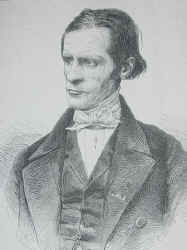Johan Christian Dahl |
Hans Fredrik Gude |
Kitty Lange Kielland
Theodor Philipsen |
Akseli Gallén-Kallela |
Eero Järnefelt
Edvard Munch |
August Strindberg |
Prince Eugen

Choose from a selected group of artists represented in the exhibition A Mirror of Nature: Nordic Landscape Painting 1840-1910.

Johan Christian Dahl
Bergen 1788 - Dresden 1857, Norwegian
J.C. Dahl occupies a central position in Norwegian artistic life of the first half of the 19th century. His Romantic yet naturalistic interpretations of Norwegian scenery aroused interest in Norway on the Continent, where Dahl himself was highly esteemed, particularly in Denmark and Germany.
Born into poverty in Bergen, Dahl's first training was as a house-painter and decorative artist in his native city. Some views he painted at this time are known. People soon noticed his talent, and a group of well-to-do citizens collected money which enabled him to travel to Copenhagen in 1811 to study at the art academy. There was no academy in Norway in those days, not until 1909. Professor C.A. Lorentzen (1746-1828) was his teacher, though Jens Juel's (1745-1802) poetic landscapes made a greater impression on young Dahl. However, it was studying the 17th-century Dutch landscapes in Danish collections that really helped him progress towards his goal of becoming the modern interpreter of Norway's scenery. In this early phase of his career he was already painting landscapes of a Nordic kind inspired by the Dutch old masters. But he was also painting and drawing direct from nature. His paintings attracted attention, and in Copenhagen he found both a clientele and friends for life.
In the autumn of 1818 Dahl left Copenhagen. His intention was to go on a study tour to the most important cultural centres in Europe. However, he got no further than Dresden, where he married and settled for the rest of his life. His true-to-nature Nordic landscapes brought a breath of fresh air to conventional artistic circles in Dresden. He soon struck up a close friendship with the great German Romantic painter C.D. Friedrich (1774-1840), and the influence of Friedrich's art is noticeable in Dahl's moonlit landscapes of the following years. In June 1820 he travelled, somewhat unwillingly, to Italy to join the Danish prince Christian Frederik and his entourage at the Villa Quisisana outside Naples. In the company of a group of German painters he evolved a new, free style for making studies - a seminal stage in his development as artist and his way of perceiving nature. He returned to Dresden in July 1821, and in 1824 he, like Friedrich, was appointed to a professorship at the Academy. In 1826 he went on a long study tour in Norway, his first visit there since leaving the country in 1811. He covered great distances in the mountainous south-west on horseback and on foot, and produced a vast number of studies on which he was to base future paintings executed in his Dresden studio. Dahl visited Norway again in 1834, 1839, 1844 and 1850, and was thus able to expand the range of his Norwegian subject-matter.
Dahl was active in promoting the preservation of historic monuments in Norway. He was also among the founding fathers of the National Gallery and the Art Society in Christiania, both of which were established in 1836. He died in Dresden in 1857.
|













